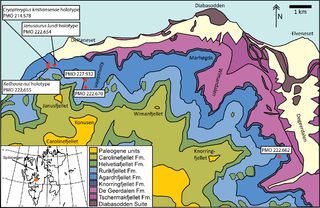 W
WThe Agardhfjellet Formation is a geologic formation in Svalbard, Norway. It preserves fossils dating back to the Tithonian to Berriasian stages, spanning the Late Jurassic-Early Cretaceous boundary. The formation contains the Slottsmøya Member, a highly fossiliferous unit (Lagerstätte) where many ichthyosaur, plesiosaur and pliosaur fossils have been found.
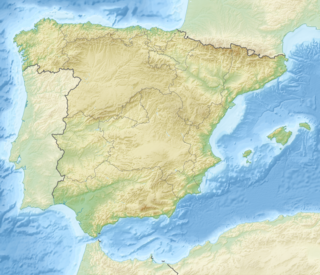 W
WThe Alacón Formation is a geologic formation in Spain in which dinosaur tracks attributed to sauropods and Iguanodontidae have been found.
 W
WThe Couches de l’Aroley are a sedimentary formation deposited during the Early Cretaceous. They consist of calcitic schists with dolomite clasts interbedded with finegrained conglomerates. The whole sequence is about 100 m thick.
 W
WThe Artoles Formation is a geological formation in Teruel and La Rioja, Spain whose strata date back to the Early Cretaceous. Dinosaur remains are among the fossils that have been recovered from the formation.
 W
WThe Ashdown Formation is a geological unit, which forms part of the Wealden Group and the lowermost and oldest part of the now unofficial Hastings Beds. These geological units make up the core of the Weald in the English counties of East Sussex and Kent.
 W
WThe Atherfield Clay Formation is a Geological formation in Southern England. Part of the Lower Greensand Group it dates to the Aptian age of the Early Cretaceous. The deposit is of marine origin largely consisting of mudstones." The pterosaur Vectidraco is known from the formation.
 W
WThe Blesa Formation is a geological formation in Teruel and La Rioja, Spain whose strata date back to the Barremian of the Early Cretaceous. Dinosaur remains as well as eggs are among the fossils that have been recovered from the formation. Along with the fragmentary anhanguerian pterosaur Iberodactylus. While the lower and upper parts of the formation were deposited in a continental setting, the middle portion of the formation is largely nearshore marine, with remains of plesiosaurs.
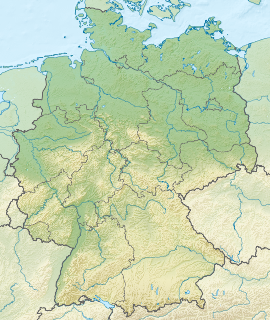 W
WThe Bückeberg Formation is a geologic formation and Lagerstätte in Germany. It preserves fossils dating back to the Berriasian of the Cretaceous period. The Bückeberg Formation has previously been considered to constitute the "German Wealden" in reference to its similarity to the Wealden Group in the United Kingdom. More recently it has been considered a group, containing the Isterberg and Deister Formations. The plesiosaur Brancasaurus, and an indeterminate ankylosaur referred to Hylaeosaurus are known from the formation.
 W
WThe La Huérguina Formation is a geological formation in Spain whose strata date back to the Barremian stage of the Early Cretaceous. Las Hoyas is a Konservat-Lagerstätte within the formation, located near the city of Cuenca, Spain. The site is mostly known for its exquisitely preserved dinosaurs, especially enantiornithines. The lithology of the formation mostly consists of lacustarine limestone deposited in a freshwater wetland environment.
 W
WThe Calizas y margas de Xert Formation or Xert Formation is an Early Cretaceous geologic formation of the Maestrazgo and Galve Basins in central-eastern Spain. The formation is described as a coastal claystone, with indications of a transgressive episode, marked by the transition from marsh facies, with little marine influence, to marine platform facies evidenced by abundant marine invertebrates.
 W
WThe Camarillas Formation is a geological formation in the Teruel Province of Aragón, Spain whose strata date back to the Early Cretaceous. The sandstones, mudstones and conglomerates of the formation, that due to syn-sedimentary faulting varies greatly in thickness from 300 to 800 metres, were deposited in fluvial, deltaic and lacustrine environments.
 W
WThe Castrillo de la Reina Formation is a geological formation in Spain. It is late Barremian to early Aptian in age. It interpreted as a fluvial deposit. It primarily consists of red clay, with ribbon shaped sandstone channel fills. The rebbachisaurid dinosaur Demandasaurus is known from the formation, alongside somphospondylan Europatitan as well as indeterminate small ornithopods, iguanodonts and spinosaurids, the earliest known stem-rhabdodontid (indeterminate) and the lizard Arcanosaurus.
 W
WThe Caranguejeira Conglomerate is an Aptian to Cenomanian geologic formation in Portugal. Dinosaur remains diagnostic to the genus level are among the fossils that have been recovered from the formation.
 W
WThe El Castellar Formation is a geological formation in La Rioja and Teruel, Spain whose strata date back to the possibly the Valanginian to the Barremian stages of the Early Cretaceous. Dinosaur remains are among the fossils that have been recovered from the formation.
 W
WThe El Collado Formation is a geological formation in Cuenca, Spain whose strata date back to the Early Cretaceous. Dinosaur remains are among the fossils that have been recovered from the formation.
 W
WThe Enciso Group is a geological formation in La Rioja, Spain whose strata date back to the Early Cretaceous.
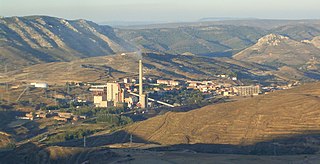 W
WThe Escucha Formation is a geological formation in La Rioja and Teruel provinces of northeastern Spain whose strata date back to the late Aptian to middle Albian stages of the Early Cretaceous. Dinosaur remains are among the fossils that have been recovered from the formation.
 W
WThe Faringdon Sand is a geologic formation in England. It preserves fossils dating back to the Cretaceous period.
 W
WThe Ferruginous Sands is a geologic formation in England. It preserves fossils dating back to the Aptian Stage of the Cretaceous period. It consists of "a number of heavily bioturbated coarsening-upward units each comprising dark grey sandy muds or muddy sands passing up into fine-to medium-grained grey to green glauconitic sands." The dinosaur Vectaerovenator is known from the formation. Shark teeth are also known from the formation, including those of an indeterminate lamniform shark and Synechodus.
 W
WThe Festningen Sandstone is an Early Cretaceous (Barremian) geologic formation in Svalbard, in the far north of Norway. Fossil ornithopod tracks have been reported from the formation.
 W
WThe Forcall Formation is an Early Cretaceous (Aptian) geologic formation in Spain. Dinosaur remains are among the fossils that have been recovered from the formation, although none have yet been referred to a specific genus.
 W
WThe Gault Formation is a geological formation of stiff blue clay deposited in a calm, fairly deep-water marine environment during the Lower Cretaceous Period. It is well exposed in the coastal cliffs at Copt Point in Folkestone, Kent, England, where it overlays the Lower Greensand formation, and underlies the Upper Greensand Formation. These represent different facies, with the sandier parts probably being deposited close to the shore and the clay in quieter water further from the source of sediment; both are believed to be shallow-water deposits.
 W
WThe Hunstanton Formation is a lithostratigraphic name applied to an early Cretaceous limestone succession in eastern England which was formerly known as Red Chalk. The type section is at Hunstanton Cliff in northwest Norfolk.
 W
WThe Jydegaard Formation is a geological formation dating to the Early Cretaceous, about 145-139 million years ago. It is on the island of Bornholm, Denmark. Vertebrate fossils have been found in the formation.
 W
WThe La Pedrera de Rúbies Formation is an Early Cretaceous (late Berriasian to early Barremian geologic formation in Catalonia, Spain. The formation crops out in the area of the Montsec in the Organyà Basin. At the La Pedrera de Meià locality, the formation consists of rhythmically laminated, lithographic limestones that formed in the distal areas of a large, shallow coastal lake. It is noted for the exceptional preservation of articulated small vertebrates and insects, similar to that of the Solnhofen Limestone.
 W
WThe Lower Greensand Group is a geological unit, part of the quite widely remaining underlying geological structure of southeast England. South of London in the counties of West Sussex, East Sussex, Surrey and Kent, which together form the wider Weald, the Lower Greensand can usually be subdivided to formational levels with varying properties into the Atherfield Clay Formation, the Hythe Formation, the Sandgate Formation, and the Folkestone Formation. North and west of London – including Cambridgeshire, Bedfordshire and Buckinghamshire – it is referred to as the Woburn Sands Formation. In Oxfordshire it is known as the Faringdon Sand. In North Wiltshire as the Calne Sands Formation and in parts of Wiltshire, Oxfordshire and Buckinghamshire as the Seend Ironstone Formation.
 W
WThe Lulworth Formation is a geologic formation in England. It dates from the late Tithonian to the mid Berriasian. It is a subunit of the Purbeck Group. In Dorset, it consists of three members, which are in ascending order, the Mupe Member, the Ridgway Member, and the Warbarrow Tout Member. The Mupe Member is typically 11 to 16 m thick and largely consists of marls and micrites with interbeds of calcareous mudstone. The Ridgeway Member is about 3 to 7 m thick and consists of in its western portion carbonaceous muds, marls and micrites, in the east the muds are replaced by micritic limestone. The Warbarrow Tout Member is 17 to 39 m thick and consists of limestone at the base and micrite and mudstone for the rest of the sequence, this member is the primary source of the vertebrate fossils within the formation. Elsewhere the unit is undifferentiated.
 W
WThe Obernkirchen Sandstein or Obernkirchen Sandstone is a geological unit in Lower Saxony, Germany whose strata date back to the Early Cretaceous. The remains of the dinosaur Stenopelix and numerous dinosaur tracks are known from the unit. The unit is a thin interval within the Bückeberg Formation As its name would suggest the lithology primarily consists of sandstone with thin intercalations of coal. This was deposited in a sandy barrier to lagoonal complex setting. The unit has historically been extensively quarried for its high quality building stone, which has been used as far away as Jakarta.
 W
WThe Papo Seco Formation is a geological formation in Portugal, whose strata date back to the Early Cretaceous. Dinosaur fossils are among the fossils that have been recovered from the formation.
 W
WThe Piedrahita de Muñó Formation is an Early Cretaceous geologic formation of the Cameros Basin in northern Spain. Fossil theropod tracks have been reported from the formation. Also fossils of Lepidotes sp., Polacanthus sp. and Testudines indet. were found in the formation.
 W
WThe Pietraroia Plattenkalk is a Cretaceous geologic formation located in the Italian municipality of Pietraroja, near Benevento, in Campania region. It is of Albian age. Dinosaur remains diagnostic to the genus level are among the fossils that have been recovered from the formation.
 W
WThe Rabekke Formation is a geological formation dating to the latest Jurassic or earliest Cretaceous, around 146 to 145 million years ago. The formation crops out on the island of Bornholm, Denmark. Vertebrate fossils have been found in the formation.
 W
WThe Robbedale Formation is a geological formation dating to the Berriasian stage of the Early Cretaceous, about 142 million years ago. It is on the island of Bornholm, Denmark.
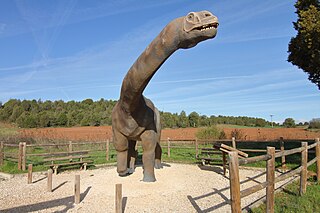 W
WThe Rupelo Formation is an Early Cretaceous (Berriasian) geologic formation in the Burgos Province of Castile and León in northern Spain. The formation crops out near the municipality Mambrillas de Lara in the northwesternmost part of the Cameros Basin in the Sierra de la Demanda.
 W
WThe Sainte-Barbe Clays Formation is a geological formation in Belgium. It is found in localised areas of the northern margin of the Mons Basin, alongside the equivalently aged Hautrage and Baudour Clay Formations. It is Upper Barremian-Lower Aptian in age. It predomiantly consists of laminated clay, with some lignite. It is well known for the "Iguanodon sinkhole" locality near Bernissart where many specimens of Iguanodon bernissartensis were discovered by Louis Dollo in the late 19th century.
 W
WThe Sandrock Formation is a geological formation in England, part of the Lower Greensand Group, it is found on the Isle of Wight and in the northern part of Swanage Bay. It consists of a cyclic rhythm of sandstones, siltstones, and mudstones.
 W
WThe Schrambach Formation is a geologic formation in the Northern Limestone Alps of Austria and Germany. It preserves fossils dating back to the Early Cretaceous period.
 W
WThe Speeton Clay Formation (SpC) is a Lower Cretaceous geologic formation in Yorkshire, northern England. The most common fossils in the unit are belemnites, followed by ammonites and the lobster Meyeria ornata. Dinosaur remains are among the fossils that have been recovered from the formation, although none have yet been referred to a specific genus.
 W
WThe Tera Group is a geological group in the Cameros Basin and Sierra de la Demanda in Burgos, Spain. The group contains several formations whose strata date back to the Early Cretaceous. Dinosaur remains are among the fossils that have been recovered from the formation.
 W
WThe Tristel Formation is a stratigraphic formation of the northern-central Alps, deposited between the late Barremian and the early Aptian of the Early Cretaceous. It consists of thickly banked limestones, marls and shales. It is the lowest formation of the Bündnerschiefer and belongs to the Rhenodanubic Group.
 W
WThe Tunbridge Wells Sand Formation is a geological unit which forms part of the Wealden Group and the uppermost and youngest part of the unofficial Hastings Beds. These geological units make up the core of the geology of the Weald in the English counties of West Sussex, East Sussex and Kent.
 W
WThe Upper Bedoulian Formation is a geological formation in the Murcia Region, Spain whose strata date back to the Early Cretaceous. The marls were deposited in an open marine environment. The lower unit is marly with iron concretions and septaria.
 W
WThe Upper Greensand Formation is a Cretaceous formation of Albian to Cenomanian in age. It is found within the Wessex Basin and parts of the Weald Basin in southern England. It overlies the Gault Clay and underlies the Chalk Group. It varies in thickness from zero to 75 m. It is predominantly a glauconitic fine-grained sandstone, locally becoming silty. Fragmenary dinosaurs remains such as those assigned to Iuticosaurus, have been recovered from this formation.
 W
WThe Urbión Group is a geological group in Castile and León and La Rioja, Spain whose strata date back to the Early Cretaceous (late Hauterivian to late Barremian. The formations of the group comprise a sequence of brown limestones in a matrix of black silt, sandstones, claystones and conglomerates deposited under terrestrial conditions, in alluvial fan and fluvial environments.
 W
WThe Vectis Formation is a geological formation on the Isle of Wight and Swanage, England whose strata were formed in the lowermost Aptian, approximately 125 million years ago. The environment of deposition was that of a freshwater coastal lagoon with occasional marine influence after the early Aptian marine transgression, transitioning from the floodplain environment of the underlying Wessex Formation. The primary lithology is of laminated grey mudstones. The Vectis Formation is composed of three geological members: the Shepherds Chine member, the Barnes High Sandstone member, and the Cowleaze Chine member. It is overlain by the fully marine Atherfield Clay Formation, part of the Lower Greensand Group. Dinosaur remains are among the fossils that have been recovered from the formation.
 W
WThe Vigla Formation is an Early Cretaceous geologic formation in Albania and Greece.
 W
WThe Wadhurst Clay Formation is a geological unit which forms part of the Wealden Group and the middle part of the now unofficial Hastings Beds. These geological units make up the core of the geology of the High Weald in the English counties of West Sussex, East Sussex and Kent.
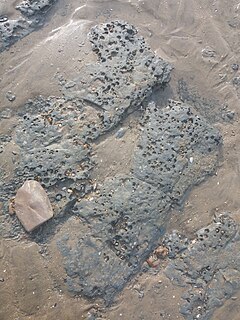 W
WWeald Clay or the Weald Clay Formation is a Lower Cretaceous sedimentary rock underlying areas of South East England, between the North and South Downs, in an area called the Weald Basin It is the uppermost unit of the Wealden Group of rocks within the Weald Basin, and the upper portion of the unit is equivalent in age to the exposed portion of the Wessex Formation on the Isle of Wight. It predominantly consists of thinly bedded mudstone. The un-weathered form is blue/grey, and the yellow/orange is the weathered form, it is used in brickmaking.
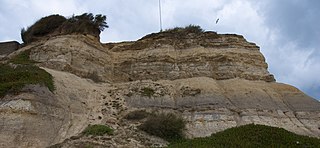 W
WThe Wealden Group, occasionally also referred to as the Wealden Supergroup, is a group in the lithostratigraphy of southern England. The Wealden group consists of paralic to continental (freshwater) facies sedimentary rocks of Berriasian to Aptian age and thus forms part of the English Lower Cretaceous. It is composed of alternating sands and clays. The sandy units were deposited in a flood plain of braided rivers, the clays mostly in a lagoonal coastal plain.
 W
WThe Wessex Formation is a fossil-rich English geological formation that dates from the Berriasian to Barremian stages of the Early Cretaceous. It forms part of the Wealden Group and underlies the younger Vectis Formation and overlies the Durlston Formation. The dominant lithology of this unit is mudstone with some interbedded sandstones. It is exposed in both the Isle of Purbeck and the Isle of Wight. While the Purbeck sections are largely barren of vertebrate remains, the Isle of Wight sections are well known for producing the richest and most diverse fauna in Early Cretaceous Europe. Regional correlations include the Upper Weald Clay of the United Kingdom, the Sainte-Barbe Clays Formation of Belgium, and the La Huérguina and Camarillas Formations of Spain.